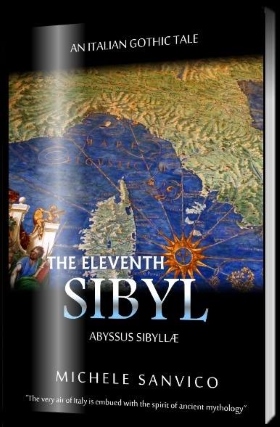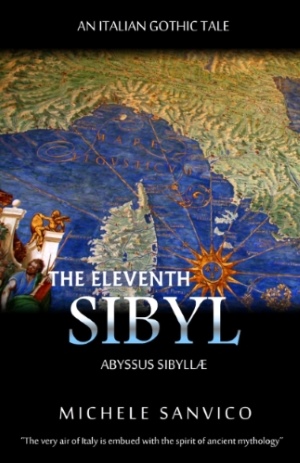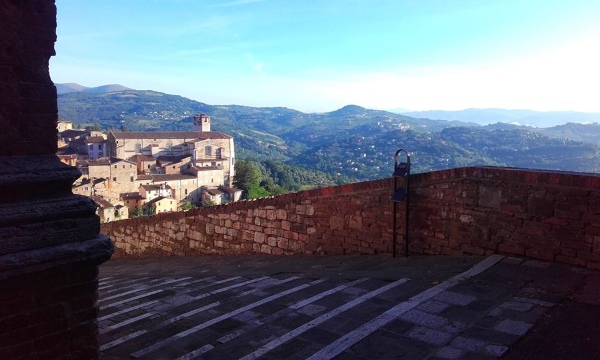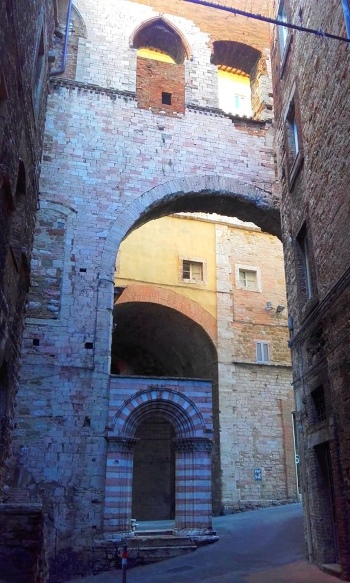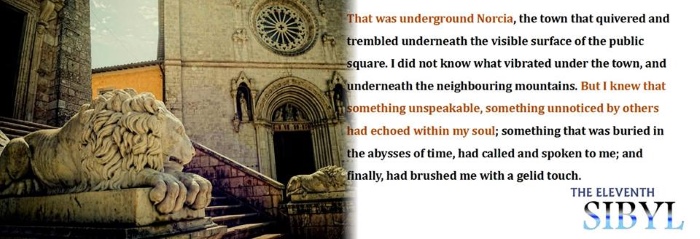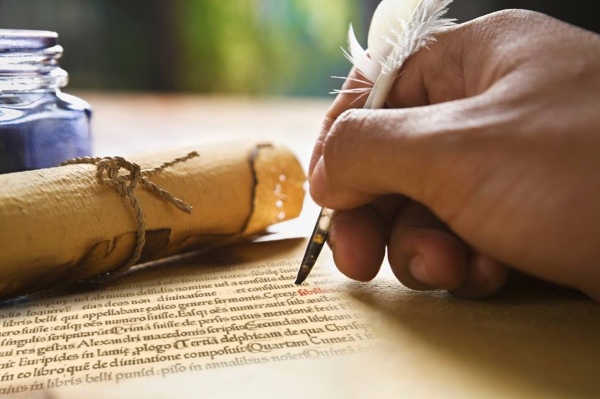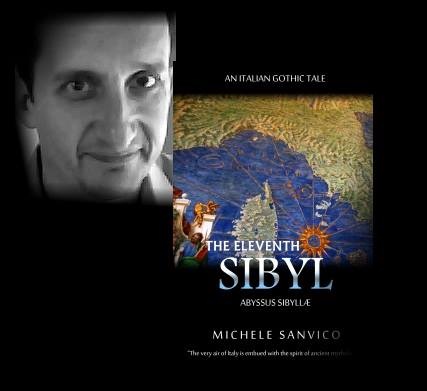14 Jul 2018
THE ELEVENTH SIBYL by Michele Sanvico
An ancient Italian tale
set between history and legend
a mountain and a cave
centuries of dreams and explorations
to find the hidden realm
of the Apennine Sibyl
Download the free ebook
on www.smashwords.com
from 1 to 31 July 2018 only.
L'UNDICESIMA SIBILLA di Michele Sanvico
Un antico racconto italiano
sospeso tra storia e leggenda
una montagna e una caverna
secoli di sogni ed esplorazioni
alla ricerca del regno perduto
della Sibilla Appenninica
Ebook gratuito su www.smashwords.com
solo dal 1 al 31 Luglio 2018
19 Nov 2016
The appalling abyss opening its jaws in the Plain of Castelluccio following 30th, Oct 2016 earthquake
Everything was already written and explained in my 2010 novel "The Eleventh Sibyl", from which I quote without any cuts:
«And he described the weird mystery of rainwater. As a matter of fact, rain used to fall copiously on the Castelluccio meadows and the surrounding Plains; in addition to that, the plateau was encircled by lofty mountains on all sides; and yet, the grassland did not turn into a vast lake, only owing to the presence of a huge chasm, the rocky hollow called the Inghiottitoio, or the Swallower, situated at the southernmost end of the Plains. To such a chasm, the great natural drainage channels named «Mèrgani» - carved in the spongy ground and the underlying layer of sedimented limestone - conveyed the many billion gallons of water that were poured each year over the grassy expanse, in the form of rain. And he explained to me that such an immense, titanic quantity of rainwater vanished altogether into the unfathomable bowels of the deep foundations of the Sibilline Range, and never did it resurface amid the scanty, ungenerous springs which, in the bordering territories of Norcia and the valley of the river Tronto, gushed with criystal-clear springs, though utterly inadequate to allow for the astounding volume of precious liquid drained into the abysses of the earth withouth giving any further sign of itself. And he told me of the attempt that Lippi-Boncambi, the illustrious geologist from Perugia, had made to assess the hidden route of the waters, by spilling an ever increasing quantity of fluorescein into the Swallower's bottomless cleft; however, the daring experiment had not yielded the result that the talented scientist had intended to achieve, as not the slightest trace of the dyeing substance was ever to be retrieved in the spring waters gushing in the contiguous valleys.
And that was the indisputable evidence, a dark and elusive omen, that beneath the Plains, in the underground limestone, concealed by the sediments of vegetal origin that for thousands of years had filled up the gigantic step; underneath the mountains which enclosed the plateau on its eastern side - Mount Vettore, Mount Argentella, the cliff of Palazzo Borghese, Mount Porche, Vallelunga's Peak and the Sibyl's turreted mountain-top - the invisible work carried out by the subterranean waters had dug vast unknown hollows and caverns and tunnels, which accommodated and stocked prodigious volumes of clear liquid, stored in icy underground lakes. And perhaps the earthquakes to come will set such waters free from their unseen basins, by creating new resurfacing springs and allowing for the drainage of the hidden reservoirs in the course of interminable ages, much longer than any human lives, spanning across periods of time as long as hundreds of thousands of years.
And, doubtless, as my friend maintained, that cavern too, the Sibyl's gloomy and inaccessible cave, placed on the summit of the hallowed and crowned mount, was a gateway to the dreadful hollows that the underground waters had carved, with a silent and secretive work of their own, into the strata made of limestone on the rocky mountain-top; and such hollows would go down, with tangled, twisty meanders, towards the mount's hidden core, connecting eventually with the natural subterranean passageways - that no human eye had ever beheld - buried under the very foundations of solid limestone which supported the Plains of Castelluccio overhead: there, waters lay in stillness, in the perennial darkness of the titanic chambers which, for millions of years, had rested in secrecy, beneath the layer of peaty sediments that had accumulated with the gradual disappearance of the ancient forests.
And who ever might tell what had actually established its abode, during the lapse - totally unknown to men - of primeval and impenetrable ages, amid the silent, imposing walls of those galleries and caves? Who might ever know what appalling, heinous actuality was concealed under the nasty, loathsome and abominable name conferred to the Sibyl of the Apennines?
When I took my leave from the quiet, hospitable house, bathed in the hilltop's sunlight, that already betokened the coming sunset, my friend held me tight, putting his hands on my shoulders, as he smiled at me in the rapidly declining light. He said nothing about a second entrance to the cavern; sure enough, it was possible that a further entryway might be disclosed to the brave and well-advised wayfarer who had determined to venture as far as the unexplored recesses of that famous and sinister cave; nonetheless, only by climbing up to the mountain-top, and carrying out an attentive search amid the broken rocks, would he be able to check in person whether that passageway existed solely in the kingdom of legends, in the fairy realm of dreams; or, instead, there was an actual chance of locating a second entrance, through which it would be possible to break one's way into the darkness and through the abysmal depths of the unknown.»
L'impressionante abisso apertosi nella Piana di Castelluccio dopo il terremoto del 30 ottobre 2016
Tutto era già scritto e spiegato nel mio romanzo del 2010 “L'Undicesima Sibilla”, dal quale cito integralmente:
«E mi descrisse il mistero inquietante delle acque piovane, di come esse cadessero copiose sull’erba e sul bacino imbrifero circostante, e di come l’altipiano, sebbene fosse chiuso d’ogni lato da alte montagne, non divenisse un enorme lago solamente grazie alla voragine pietrosa, gigantesca dell’Inghiottitoio carsico, che si trovava all’estremità meridionale del pianoro, verso il quale gli enormi fossi naturali chiamati «Mèrgani», scavati nella terra soffice e nel sottostante strato di sedimenti calcarei, convogliavano i milioni e milioni di metri cubi d’acqua che ogni anno si riversavano, su quella distesa erbosa, sotto forma di pioggia. E mi spiegò come questa immensa, colossale massa d’acqua sparisse nelle viscere sconosciute del basamento profondo dei Monti Sibillini, senza riapparire mai tra le modeste, avare sorgenti che, nei territori confinanti di Norcia e della valle marchigiana del Tronto, sgorgavano con limpidi zampilli, inadeguati però a dar conto della prodigiosa quantità di liquido prezioso inabissatosi, senza mai più fuoriuscirne, nel ventre della terra. E mi narrò di come Lippi-Boncambi, il famoso geologo perugino, avesse tentato, nel 1947, di tracciare il percorso segreto delle acque, versando nel baratro insondabile dell’Inghiottitoio quantità a mano a mano crescenti di fluoresceina; ma l’ardito esperimento non aveva prodotto i risultati che l’ingegnoso uomo di scienza si era prefigurato, non ricomparendo mai segno alcuno del colorante dalle sorgenti stillanti nelle vallate sottostanti.
Ed era questa la prova, l’annuncio cupo, sfuggente che al di sotto della Piana, nel sottosuolo calcareo, occultato dai sedimenti vegetali che nei millenni avevano colmato il gigantesco gradino, sotto le stesse montagne che verso oriente orlavano l’altipiano, il Monte Vettore, il Monte Argentella, Palazzo Borghese, il Monte Porche, Cima Vallelunga, e la cima turrita della Sibilla, l’opera invisibile del carsismo aveva scavato enormi cavità segrete, grotte e cunicoli in grado di ospitare e trattenere immense quantità di acqua, gelidi laghi sotterranei, che i terremoti, forse, avrebbero in futuro liberato del loro contenuto, aprendo nuove sorgenti, provocando lo svuotamento dei bacini nascosti nel corso di ere interminabili, ignote all’uomo, traversando abissi di tempo che si sarebbero misurati in centinaia di migliaia di anni.
E certamente, affermava il mio amico, anche quella spelonca, la grotta oscura e sigillata della Sibilla, posta sulla cima del sacro monte coronato, non poteva che procurare l’accesso agli antri spaventosi che le acque carsiche avevano intagliato, con lavorìo silenzioso e segreto, negli strati calcarei della vetta pietrosa, discendendo poi con tortuosi, labirintici meandri verso il cuore sotterraneo della montagna, e ricongiungendosi quindi con i cunicoli naturali, mai visti da occhio d’uomo, sepolti sotto il basamento di calcare massiccio che sosteneva l’altipiano di Castelluccio, dove le acque giacevano immote, silenti, nel buio perenne delle cavità titaniche che, da milioni di anni, esistevano nella tenebra, oltre il manto di sedimenti carboniosi originatosi con la scomparsa delle antiche foreste.
Chi poteva dire cosa avesse stabilito la propria dimora, nel volgere sovrumano di età arcaiche e incommensurabili, tra le pareti mute e solenni di quei cunicoli, di quelle grotte? Chi poteva conoscere quale spaventosa, raccapricciante realtà si occultasse al di sotto dell’appellativo nefasto, immondo, esecrabile attribuito alla Sibilla degli Appennini?
Quando lasciai la casa accogliente, tranquilla, immersa nel sole del crinale, nell’ora che preannunciava il tramonto, il mio amico mi abbracciò, ponendo entrambe le mani sulle mie spalle, sorridendo nella luce rapidamente calante. Nulla mi disse egli a proposito del secondo ingresso alla grotta; era certamente possibile che una duplice via si palesasse al viandante, audace e sapiente, che avesse inteso intraprendere il viaggio verso gli inesplorati recessi di quell’antro sinistro e rinomato; ma solo ascendendo fino a quella cima, e frugando tra quelle rocce dirupate, sarebbe stato possibile verificare di persona se quell’ingresso esistesse solamente nel reame del mito, nel territorio fiabesco del sogno; o se, al contrario, non fosse realmente possibile rinvenire un secondo imbocco, tramite il quale penetrare nel buio e nella profondità dell’ignoto.»

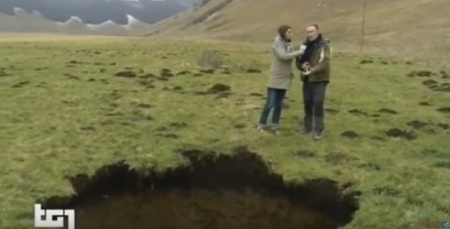
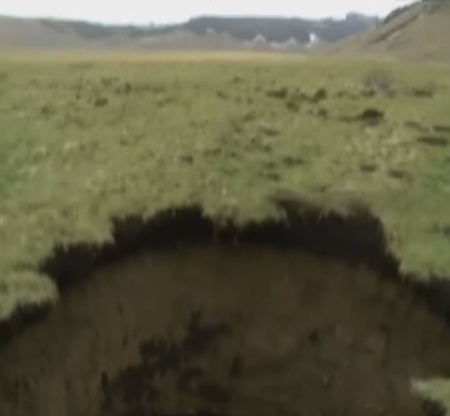

28 Sep 2016
Funding assigned to writer Michele Sanvico for his novel "The Eleventh Sibyl"
On August, 1st 2016, Italian author Michele Sanvico was qualified eligible for funding provided by the Consortium of Local Authorities 'Nera & Velino Rivers' based in Cascia, Umbria.
The funding was assigned for the production of printed copies of "The Eleventh Sibyl - Special Edition", Michele Sanvico's novel dedicated to the mythical aspects and historical roots of the Apennine Sibyl's legend. The literary work was considered as a fine example of cultural and artistic effort intended for the promotion of local tradition and lore, with the ultimate goal of increasing tourism in the territory served by the Consortium.
The Consortium of Local Authorities 'Nera & Velino Rivers' is a public authority including thirteen municipalities in the easternmost portion of Umbria (Italy). Since 1956 the Consortium operates with manifold initiatives for the social and economic progress of local population residing in the area.
Assegnato un finanziamento allo scrittore Michele Sanvico per il romanzo "L'Undicesima Sibilla"
Il 1° agosto 2016, lo scrittore Michele Sanvico ha ottenuto un finanziamento erogato dal Consorzio del Bacino Imbrifero Montano 'Nera e Velino', con sede in Cascia (PG).
Il finanziamento è stato erogato per la stampa di copie di “L'Undicesima Sibilla – Edizione Speciale”, il romanzo di Michele Sanvico dedicato agli aspetti fiabeschi e alle radici storiche della leggenda della Sibilla Appenninica. L'opera letteraria è stata considerata come iniziativa di pregevole e rilevante spessore culturale, artistico, intesa a far emergere aspetti peculiari della cultura e delle risorse locali nell'ambito del territorio servito dal Consorzio.
Il Consorzio del Bacino Imbrifero Montano 'Nera e Velino' è un ente pubblico locale, consorzio obbligatorio comprendente 13 Comuni ricadenti nell'alta Valnerina, più i Comuni di Foligno, Spoleto e Campello sul Clitunno. Sin dal 1956 il Consorzio opera per il progresso economico e sociale delle popolazioni interessate.
20 Sep 2016
"The Eleventh Sibyl" now available on paper
The very air of Italy is embued with the spirit of ancient mythology. Weird legends about the gods of the classical world still live under the shadows of the Italian woods and beneath the rocky slopes of solitary peaks. When I first discovered the story about the Sibyl, I decided at once to write a novel on the subject. The belief in this legend was once so strong that since five centuries ago the place has achieved remarkable renown in France, Germany and other European countries. This was an awe-inspiring story that needed to be told. And the legend of the Sibyl became a book, narrating the quest for the divine dweller of the cave carried out by the novel's main character. A "gothic" investigation through old books and fragments of truth retrieved on the Mount Sibyl, which will take the hue of a sinister journey into a mystery dating back to the Roman age. And, in a final encounter with the legendary Queen, the Sibyl will prove as dreadful as a terrifying dream.
"L'Undicesima Sibilla" ora disponibile in volume cartaceo
Un moderno esploratore sulle tracce di un'antica leggenda. Un viaggio avventuroso tra libri consumati dai secoli, resoconti di avventurieri e testimonianze di arditi viaggiatori. In cerca della Sibilla, o meglio, di una Sibilla: quella Appenninica, che vivrebbe al di sotto di una montagna posta tra l'Umbria e le Marche. Da Norcia - piccolo paese ricco di fascino e di storie - il protagonista di "L'Undicesima Sibilla" tenterà di dipanare quel filo che si snoda attraverso i secoli, seguendo gli indizi nascosti che raccontano del mito della Sibilla. E affrontando infine quella montagna, il Monte della Sibilla, svelandone il segreto celato da tempo immemore sotto immani spessori di roccia. Un viaggio iniziatico contemporaneo. Un'inchiesta che è molto più di un thriller. Una storia affascinante, narrata con un linguaggio di grande qualità stilistica ed espressiva. Un romanzo che vi lascerà a bocca aperta, conquistandovi l'anima. Dalla prima all'ultima pagina.
5 Sep 2016
The hometown of St. Benedict and the earthquakes
"Norcia. An inhuman beast lived unseen under the ground, awaiting. Beneath the square and the streets and the ancient dwellings of men, the faceless being with gleaming, sightless eyes waited patiently, in a dream. Its dream, the dream of a dark subterranean potency lasted for whole lifetimes of men, looming over them as though heavy, rolling vapours announcing the coming of a storm; until, all of a sudden, the blind, faceless beast awoke, and manifested its cruel abomination across the surface of the earth".
La città di San Benedetto e i terremoti
"Norcia. Una bestia inumana, oscura, viveva infatti nel sottosuolo, attendendo. Al di sotto della piazza, delle strade, degli antichi palazzi degli uomini, l’essere privo di sembiante, dagli occhi ciechi e lucenti, aspettava paziente, sognando. Il suo sogno, il sogno della nera potenza del sottosuolo, durava intere vite umane, incombendo su di esse come turgida nube di tempesta; finché, all’improvviso, la belva senza volto, senza occhi, si risvegliava, e manifestava il suo feroce abominio sulle distese della terra."
31 Aug 2016
Norcia, the 1859 earthquake
Many years ago, when I was writing the second chapter of my novel "The Eleventh Sibyl", in which I depicted the ruinous 1859 earthquake in Norcia, I would never have imagined that I would make a similar experience in Norcia in August 2016 - luckily enough with no collapse of the building where I was sleeping in. Here is what I wrote then:
"So it had begun, on August, 22nd 1859. Since a few days before, the ground had been shaking faintly, softly, as if to caution, to signal that the inhuman sleep, after long, drowsy years, was now over. [...]
Like a tremendous, gigantic mace, the earthquake struck. First, there came the roar. A baleful, fiendish noise, which proceeded from the abysses underneath, growing louder and louder, as though a titan wounded to death implored with fury mercifully to be put down.
Then, the shock arrived. The world began to sway, slowly at first, with a dull oscillating motion, from right to left, and next from left to right, and once again from right to left, as the first thick fragments of plaster were starting to detach from the walls, and frenzied animals, raising loud, terror-stricken calls, were rushing about frantically, as if they were bewildered corpses brought back abruptly to life from the realm of the dead.
And, at last, the surface of the earth surged. The beast screamed with enraged might; like a shroud, its thundering voice covered the horrified wails of the human beings. The world was blown up from
the inside; walls opened up; roofs collapsed, madly shaken; wrecked stones, broken shingles, ruined beams of wood were all crashing to the ground, burying and crushing flesh and blood and wreckage, while for long, interminable seconds the shock went on, smashing steadfastly, banging men and earth as a hammer being wielded by the crazy hands of a madman.
Afterwards, all lay still in death, destruction, and silence.
The beast had come and gone. Once again it had drowsed into its dreamful sleep; and many years would elapse before it awakened anew."
Norcia, il terremoto del 1859
Molti anni fa, mentre ero impegnato nella scrittura del secondo capitolo del mio romanzo “L'Undicesima Sibilla”, nel quale descrivevo il terribile terremoto del 1859 a Norcia, non avrei mai immaginato che io stesso avrei potuto vivere una esperienza simila nella medesima città di Norcia nell'Agosto 2016 – fortunosamente senza subire il collasso dell'edificio all'interno del quale stavo dormendo. Ecco cosa scrissi all'epoca:
«Così era cominciata, quel 22 agosto del 1859. Da alcuni giorni la terra tremava, flebilmente, dolcemente, come ad avvisare, a dare un segnale che il sonno ferino, dopo lunghi, torpidi anni, era finito. [...]
Come una mazza gigantesca, titanica, il terremoto colpì. Dapprima, giunse il rombo. Un suono funesto, demoniaco, che procedeva dalle profondità del sottosuolo, aumentando progressivamente di intensità, come un titano ferito a morte, che implorasse con furore di essere misericordiosamente abbattuto.
Poi, la scossa arrivò. Il mondo cominciò a tremare, piano inizialmente, con un movimento lento e oscillatorio, da destra a sinistra, e ancora da sinistra a destra, e poi di nuovo da destra a sinistra, mentre le prime porzioni di intonaco già cominciavano a staccarsi dalle mura, e gli animali, impazziti, correvano attorno scompostamente, gridando, in cerca di scampo, come cadaveri privi di volontà che fossero stati repentinamente resuscitati dal mondo dei morti.
E, infine, la terra si sollevò. La bestia urlò con furia immane; come un sudario, la sua voce di tuono ricoprì i lamenti d’orrore dei viventi. Il mondo esplose dall’interno; le mura si aprirono, i tetti, scrollati freneticamente, franarono; le pietre divelte, le tegole spezzate, le travi di legno mozzate si schiantarono al suolo, seppellendo e schiacciando ogni cosa, carne e sangue e detriti, mentre per lunghi, infiniti secondi la scossa proseguiva, batteva, si accaniva, percuotendo la terra e gli uomini come un martello brandito e manovrato dalle mani insensate di un folle.
E tutto fu morte, distruzione e silenzio.
La bestia era venuta, e se ne era andata. Ancora essa ricominciò a dormire, e a sognare; e lunghi anni sarebbero nuovamente trascorsi prima che si risvegliasse un’altra volta.»


28 Aug 2016
"The Eleventh Sibyl" now available on Smashwords
Italy, 2010. Norcia, the most picturesque town of Apennines. An antique book, with a golden sun impressed on its cover. A creepy story re-emerging from a long-gone past: the legend of the Sibyl, the evil goddess who once lived in a cavern on the top of a desolate cliff, Mount Sibyl. Just old wives' tale? Follow a man's journey into mystery and madness, up to the final, dreadful encounter. Now available on Smashwords.
"L'Undicesima Sibilla" ora disponibile su Smashwords
Italia, 2010. Norcia, la città più affascinante di tutti gli Appennini. Un antico volume, con un sole raggiante impresso sulla copertina. Una storia spaventosa che riemerge da un passato lontano: la leggenda della Sibilla, la divinità malvagia che un tempo viveva all'interno di una caverna posta su di una vetta desolata, il Monte Sibilla. Solo chiacchiere di vecchie comari? Seguite il viaggio del protagonista attraverso l'incubo e il mistero, fino al terribile incontro finale. Ora disponibile su Smashwords.
3 Aug 2016
Town of beauty and sanctity
Writer Maria Sticco on Perugia: «this contrast between narrow and airy, solemn and joyful, urban and rustic is a true echo of the town's own history, engraved in murder and sanctity, fine arts and stillness» («questo contrasto di angusto e di amplissimo, di cupo e di ridente, di urbano e di agreste si riflette nella sua storia fatta di violenza e di santità, di grande arte e di silenzi»).
Città di bellezza e santità
Ancora Maria Sticco, scrittrice, su Perugia: «questo contrasto di angusto e di amplissimo, di cupo e di ridente, di urbano e di agreste si riflette nella sua storia fatta di violenza e di santità, di grande arte e di silenzi».
3 Aug 2016
Perugia, a sweet horizon
Maria Sticco, an illustrious writer who lived in the first half of twentieth century, deeply loved the town of Perugia. Here is another Sticco's masterly excerpt on the ancient Etruscan city: «... and yet, all of a sudden, at the very end of a small lane, a superb landscape appears, gently declining towards the slopes of distant mountains, as sweet as closed lips holding back words of love for chaste restraint of their own».
Perugia, dolci orizzonti
Maria Sticco, una grande scrittrice vissuta nella prima metà del XX secolo, ha amato profondamente Perugia, in Umbria. Ecco un bellissimo brano che descrive l'antica città di origine etrusca: «... ma in fondo, a un tratto, un orizzonte splendido che declina sulle curve dei monti, dolci come labbra chiuse per intimo divieto alle parole di amore».
3 Aug 2016
The ancient stones of Perugia
A chapter of my novel "The Eleventh Sibyl" is set in the old town of Perugia, in Italy, a magnificent scenario that was once depicted by author Maria Sticco with the following words: Perugia, the town which «enfolds herself in her own medieval streets, hemmed in between towering buildings tarnished by the lapse of centuries; dusky alleys, passageways with sloping steps, shadowy courtyards, and sombre palaces...»
Le antiche pietre di Perugia
Un capitolo del mio romanzo “L'Undicesima Sibilla” è ambientato nell'antica città di Perugia: uno scenario magnifico, che è stato descritto in passato dalla scrittrice Maria Sticco con queste parole: Perugia, che «internamente si raccoglie nelle sue vie medievali strette fra le altissime case patinate dai secoli: angiporti scuri, viuzze a gradinate, androni cupi, palazzi bruni...»
8 May 2016
Call of the Sibyl
Rome is an amazing city: you can live for years in it, and all the same be stunned by sudden visions that are as unbelievable as utterly moving.
That happened to me today when I climbed, for the first time in my life, the staircase of the Biblioteca Angelica, near Piazza Navona: a time capsule emerging straight from the seventeenth century, carrying its load of illuminated books and manuscripts. Needless to say that no Roman resident knows anything about the existence of such a treasure, as they are entangles in endless discussions about past and on-going football matches.
For a writer like myself - and for a writer who wrote especially of ancient books in the novel "The Eleventh Sibyl" - some kind of magic acted on my visit: on entering the vast, wooden-shelved room, a book was there, at all appearances waiting for me - and me alone. It was on display for the visitors, who where allowed to take it in their hands (a thoroughly unusual condition for a book printed in the late fifteenth century).
It was printed in Subiaco, where since 1464 the first movable-type printing press in Renaissance Italy had been in operation: just like the book which is found in Norcia by the main character of my novel. And the coincidence was not over at all: it was a most rare and precious copy of the "Speculum Orbis Terrae", a collection of geographical maps edited by Cornelis de Jode in Antwerp in 1593, very similar to another book I quoted in "The Eleventh Sibyl" (Abraham Oertel's "Theatrum orbis terrarum").
And - just like the main character of "The Eleventh Sibyl" - I could touch the book with my hands, turn the pages and go to the map I felt was calling for me: the "Marcae Anconitanae sive Piceni Agri".
There, I found (just like the tale I myself wrote in my novel) a caption written in small, elegant characters: "La grotta della Sibilla", the Sibyl's cave.
Life is somehow odd and obscure, and we cannot but heed to what distant voices from long-gone centuries still have to say to us.
Il richiamo della Sibilla
Roma è una città sorprendente: puoi viverci per anni interi, e rimanere comunque stupefatto di fronte a visioni di imprevista bellezza, tanto incredibili quanto commoventi.
Questo è esattamente quanto è accaduto al sottoscritto alcuni mesi fa, quando mi è capitato di salire, per la prima volta nella mia vita, i gradini della Biblioteca Angelica, non distante da Piazza Navona: una sorta di capsula del tempo, riemergente direttamente dal diciassettesimo secolo, con il suo carico di preziosi manoscritti e volumi. Non c'è bisogno di segnalare come a nessun cittadino di Roma capiti di sapere assolutamente alcunché in merito all'esistenza di un tale tesoro, essendo essi troppo impegnati in estenuanti discussioni sulle partite di calcio passate, presenti e future.
In occasione della visita di uno scrittore - e, in particolare, di uno scrittore come me che, nel romanzo "L'Undicesima Sibilla", ha sistematicamente tratto molteplici citazioni da numerosi libri antichi - sembra che sia stata operata una qualche sorta di speciale magia: al mio ingresso nell'enorme sala ricolma di scaffali di legno, si presentava infatti al mio sguardo un libro, in tutta apparenza destinato proprio a me - e a me solo. Era appoggiato su di un leggìo, a disposizione dei visitatori, ai quali era addirittura permesso sfogliarne le antiche pagine (una circostanza alquanto inusuale per un volume pubblicato nella seconda metà del quindicesimo secolo).
Si trattava di libro stampato a Subiaco, dove sin dal 1464 era attiva la prima pressa a caratteri mobili dell'Italia rinascimentale: esattamente come l'analogo volume nel quale il protagonista del mio romanzo si imbatte, una sera, a Norcia. E le coincidenze non erano finite: il libro dell'Angelica era una rarissima copia dello "Speculum Orbis Terrae", una raccolta di antiche carte geografiche curata da Cornelis de Jode in Antwerp nel 1593 - molto simile dunque ad un altro libro da me menzionato ne "L'Undicesima Sibilla" (il "Theatrum orbis terrarum" di Abraham Oertel).
E - esattamente come accade al protagonista de "L'Undicesima Sibilla" - potei toccare quel libro con le mie mani, voltarne le pagine illustri e giungere fino alla mappa che io sentivo stesse elevando il suo richiamo verso di me: la "Marcae Anconitanae sive Piceni Agri".
Su quella mappa (esattamente come nel racconto riportato nel mio romanzo), potei osservare una didascalia, scritta in piccoli, eleganti caratteri: "La grotta della Sibilla".
La vita, talvolta, è strana e oscura, e noi non possiamo far altro che ascoltare ciò che voci distanti, parlando da secoli ormai da lungo tempo trascorsi, hanno ancora da dire alle nostre anime.
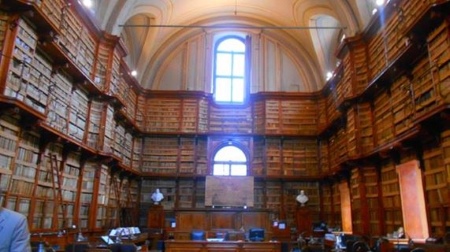
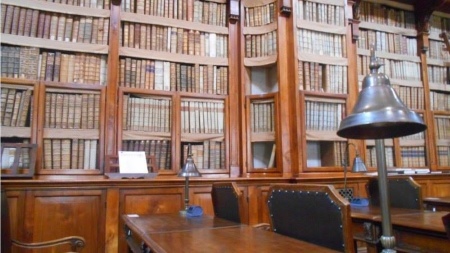

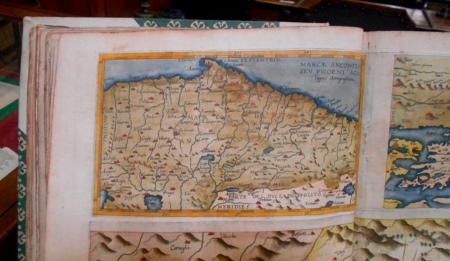


5 May 2016
A novel's idea
When I first got to Mount Sibyl's peak in 2009, I could feel all the strength of the legend connected to its cave. The entrance was in ruin, and yet the place expressed all its mysterious spell. The rotten wooden beams still laying on the ground bore witness to the efforts made in 1920s and 1950s to break into the cave. The story was worth telling, and that's how "The Eleventh Sibyl" saw the light.
L'idea per un romanzo
Quando giunsi per la prima volta sul picco della Sibilla, nel 2009, potei percepire tutta la forza della leggenda che riguardava la caverna posta sulla cima. L'ingresso era crollato, e malgrado ciò il luogo esprimeva pienamente tutto il suo fascino misterioso. Le travi di legno marcito che ancora giacevano al suolo testimoniavano degli sforzi effettuati tra il 1920 e il 1950 per tentare di penetrare nella grotta. Valeva la pena di raccontare quella storia, ed ecco come "L'Undicesima Sibilla" ha visto la luce.
15 Jan 2016
Journeying into mystery
"THE ELEVENTH SIBYL" is Michele Sanvico's novel leading the reader into the depth of the Apennine Sibyl's mystery. It's a travel into a secret that has been preserved for a period of two millennia, from the early clues scattered in the works of a handful of Latin authors to the advanced research carried out with high-tech devices in present days. It's the story of a mythical tale and the people who tried to unveil the truth hidden behind the legend.
Viaggiando nel mistero
"L'UNDICESIMA SIBILLA", di Michele Sanvico, è il romanzo che conduce il lettore nelle profondità del mistero della Sibilla Appenninica. È un viaggio all'interno di un segreto che è stato custodito per oltre due millenni, a partire dai primi tenui indizi rinvenibili nelle opere di una manciata di autori latini, fino ad arrivare alle avanzatissime ricerche condotte ai nostri giorni con le più moderne tecnologie. È la storia di un racconto leggendario, e di tutti quegli uomini che hanno tentato di sollevare il velo che copre la verità, nascosta da un mito antico come le stesse montagne.
10 Jan 2016
The challenge of Mount Vettore
Only the huge, imposing mass of Mount Vettore, crowned with divine refulgence, challenges the nocturnal sky, a cosmic void spangled with distant suns whose brightness utterly disappears under the moon's fierce blaze. Only the rocky bulk of that titanic mountain, hauled with anger onto earth from the womb of a perished sea, stands against the giant chasm above, eternally falling into the motionless darkness of deep space.
La sfida del Monte Vettore
Solo la mole imponente, superba del Monte Vettore, cinta di divina radianza, osa sfidare quel cielo notturno, quel cosmico vuoto punteggiato di soli distanti, occultati dall’aspro riverbero del disco lunare; solo quella massa titanica, scagliata nel mondo con furia dal grembo di un mare scomparso, fronteggia l’immane voragine che follemente precipita verso la tenebra profonda, immota dello spazio.
9 Nov 2015
Lovecraft in Italy
A main inspiring model for the writing of my novel "The Eleventh Sibyl" has certainly been H. P. Lovecraft, the master of horror tales from Providence. A similar sense of fear for the unknown and the inhuman pervades my work, the way it casts an eerie light over HPL's literary works. The question was: would I be able to transfer the distinctive characters of a narrative atmosphere designed for Chtulhu and Innsmouth to an Italian setting and an utterly different mythology such as the one of the Apennine Sibyl?
It was not a matter of copying or twisting HPL into a frame that wasn't his: instead it was a question of how to process the personal feelings and literary nourishment that I had drawn from Lovecraft into something new, that should be only mine, and not a bad imitation of the style and topics of a great American author.
I think I achieved my task: the features of the Sibyl's legend - the inhuman, the concealed, the horrific - have been turned into a real uncanny tale, building on HPL's heritage but playing the story with different Italian notes: the picturesque, the layers of history sedimented one over another on the Italian territory, the dying memory of the past, the contemporary society of consumers only focused on the purchase of smartphones and cars. At the very end the reading is fresh and compelling, and I thank HPL for having raised in me a special sensitivity for the unknown, now stated in my novel with a new style. New, previously untold shivers run down the spine of the reader.
Lovecraft in Italia
H. P. Lovecraft, il maestro dei racconti dell'orrore di Providence, ha certamente costituito un modello di ispirazione fondamentale per la scrittura del mio romanzo “L'Undicesima Sibilla”. Un senso lovecraftiano di paura per ciò che è ignoto ed inumano pervade il mio lavoro, analogamente alla luce inquietante e sinistra con la quale HPL illumina le sue opere. La domanda era: sarei stato capace di trasferire i caratteri distintivi di un'atmosfera narrativa pensata per Chtulhu e Innsmouth ad un'ambientazione italiana e ad una differente mitologia, quale quella della Sibilla Appenninica?
Non si trattava di copiare o forzare HPL in un quadro che non gli appartiene: piuttosto, il problema era quello di capire come elaborare sentimenti e sensazioni personali, nonché un copioso nutrimento letterario tratto dall'autore americano, per trasformarlo in qualcosa di nuovo, che fosse unicamente mio, e non una cattiva imitazione dello stile e dei temi di un grande maestro d'oltreoceano.
Io credo di essere riuscito nel mio intento: gli aspetti peculiari della leggenda della Sibilla – l'inumano, il nascosto, l'orribile – sono stati trasposti in un racconto realmente sinistro, basato sull'eredità di HPL ma interpretato secondo note tipicamente italiane: il pittoresco, gli strati storici sedimentati l'uno sull'altro sulla terra d'Italia, la memoria morente del passato, la società dei consumi contemporanea, concentrata sull'acquisto di auto e smartphone. Il risultato è una lettura fresca ed entusiasmante, e posso certamente ringraziare HPL per avere nutrito in me una speciale sensibilità per quanto è sconosciuto, una sensibilità pienamente espressa all'interno del mio romanzo con uno stile nuovo e personale. Nuovi brividi, mai raccontati prima, possono dunque correre oggi lungo la schiena del lettore.


21 Oct 2015
Underneath Norcia
“That was underground Norcia, the town that quivered and trembled underneath the visible surface of the public square: a town which had been in existence since remotely distant ages; a town which had lived, rejoiced, prayed, and endured suffering for innumerable generations of men; a town that had been struck down and then had flourished again, and again, from the wreck of its own buildings, with stubborn, unceasing resolution.
I did not know what vibrated under the town, and underneath the neighbouring mountains. But I knew that something unspeakable, something unnoticed by others had echoed within my soul; something that was buried in the abysses of time, had called and spoken to me; and finally, had brushed me with a gelid touch.
And Sibyl was its name.”
Al di sotto di Norcia
"Era questa la Norcia che tremava, vibrava al di sotto della superficie delle cose: una città che era esistita sin da tempi remoti e inaccessibili; che aveva vissuto, gioito, pregato, sofferto per innumerevoli generazioni; che era crollata, ed era poi risorta, più e più volte, dalle rovine delle proprie strade e delle proprie case, con caparbietà e risoluta determinazione.
Io non sapevo che cosa vibrasse al di sotto della città, all’interno delle vicine montagne. Sapevo solo che qualcosa di indicibile, di negletto, aveva riecheggiato in me; una cosa sepolta nell’abisso dei secoli aveva chiamato, mi aveva parlato, e con gelido tocco mi aveva sfiorato.
E il suo nome era Sibilla."
12 Oct 2015
The encounter with the Sibyl
In my novel "The Eleventh Sibyl", there is a point when the main character runs into a fundamental clue, the one that will provide him with the key to the mystery of the Apennine Sibyl. And he writes down the following words:
"A conclusive, undisputable certainty had eventually grown in me: Carlo Renzi - the merchant from Norcia, the philanthropist, the man who died in Rome in the early summer of the year 1839 - at some point of his earthly life, had had a close encounter, in his actual person, with the eerie, abominable creature who uttered words with the voice of the Great Mother - the entity «who speaks mournful words with delirious lips», and who had been dwelling for endless centuries in the dark recesses of the mountains lying near Norcia.
Of one thing I now felt assured: he had actually encountered the Apennine Sibyl."
L'incontro con la Sibilla
Nel mio romanzo “L'Undicesima Sibilla”, vi è un passaggio nel quale il protagonista si imbatte in un indizio fondamentale, quello che gli fornirà la chiave di accesso al mistero della Sibilla Appenninica. Ed egli scrive le seguenti parole:
«Era ormai maturata in me una certezza ineludibile, assoluta: Carlo Renzi, nursino, benefattore, commerciante, deceduto a Roma al principio dell’estate del 1839, in un qualche momento della sua esistenza terrena, aveva avuto un incontro, privato, personale, diretto, con quell’entità agghiacciante, disumana, terrifica, che parlava con la voce della Grande Madre, «proferendo con bocca folle parole senza riso», e dimorava, da molti secoli, nel ventre oscuro delle montagne di Norcia.
Egli, io ne ero certo, aveva incontrato la Sibilla Appenninica.»
7 Oct 2015
Ascending the Sibyl's peak
The idea of writing a novel on the Sibyl's legend came to me following a trip to the Sibillini Range and a walk to Mount Sibyl. While panting up the windy trail that led to the cliff, I wondered what I would find on the mountain-top. A cave? A shrine? Other tourists like myself hiking the places of the old legend?
I walked, and I realized that I didn't know much about the Sibyl's ancient mystery. How could I retrieve more information on the mythical goddess? Nobody, in the towns and villages surrounding the mountainous chain, seemed to know nothing about that eerie peak, long since the destination of ranks after ranks of adventurers and necromancers.
So I decided to perform my own search: books, newspaper articles, old quotes and pictures. I began my personal investigation of the Sibyl's case: an enquiry that the reader can retrace in my novel "The Eleventh Sibyl".
Salendo al picco della Sibilla
L'idea di scrivere un romanzo sulla leggenda della Sibilla nacque nella mia mente dopo un viaggio nei Sibillini e un'escursione al Monte della Sibilla. Mentre percorrevo faticosamente il ripido e ventoso sentiero che conduce alla vetta, mi domandavo cosa avrei potuto trovare sulla cima. Una grotta? Una sorta di santuario? Altri turisti che, come me, andavano cercando le tracce di antiche leggende?
Camminavo, e sapevo di non conoscere quasi nulla a proposito dell'antico mistero della Sibilla. Come avrei potuto trovare qualche informazione sulla leggendaria divinità? Nessuno, nei paesi e nei villaggi che circondano la catena montuosa, sembrava conoscere nulla su quella rupe sinistra, da secoli meta di avventurieri e negromanti.
Così decisi di effettuare la mia personale ricerca: libri, articoli di giornale, vecchie citazioni, fotografie. Cominciai dunque la mia peculiare investigazione del Caso Sibilla: un'inchiesta che il lettore potrà ripercorrere nel mio romanzo “L'Undicesima Sibilla”.


3 Oct 2015
The Apennine Sibyl in a charming novel
"The Apennine Sibyl - A Mystery and a Legend", the webpage of Italian writer Michele Sanvico and his novel "The Eleventh Sibyl".
La Sibilla Appenninica in un romanzo unico
"Sibilla Appenninica - Il Mistero e la Leggenda", la pagina web dello scrittore Michele Sanvico e del suo romanzo "L'Undicesima Sibilla".
23 Set 2015
The birth of a novel
When I made up my mind and started writing "The Eleventh Sibyl", I wasn't totally aware of the large amount of information that was to be found on the Apennine Sibyl and the town of Norcia both in ancient literature and contemporary travel books. The myth of the Sibyl had so enthralled a number of very different authors - from Antoine de La Sale to Ludovico Ariosto, and up to references to Norcia in John Milton's works - that I was flooded with quotes and excerpts.
My idea was to write a novel where historical data could intermingle with fictional narrative, where an investigating character might seize the near end of a thread that was unweaving throughout many centuries from a long distance in time.
That thin, uncanny thread was now in my hands. No other novelist had ever approached that topic before. Now it was up to me to pass the thread on to the reader. And the final result of my effort was "The Eleventh Sibyl".
Nascita di un romanzo
Quando decisi di cominciare a scrivere “L'Undicesima Sibilla”, non ero pienamente cosciente della grande mole di informazioni nella quale mi sarei imbattuto in relazione alla Sibilla Appenninica e alla città di Norcia, sia all'interno della storia della letteratura che nei moderni resoconti di viaggio. Il mito della Sibilla aveva talmente affascinato una schiera di autori molto diversi tra loro – da Antoine de La Sale a Ludovico Ariosto, fino ai riferimenti a Norcia reperibili nell'opera di John Milton – che mi ritrovai sommerso tra moltissimi brani e citazioni.
La mia idea era quella di scrivere un romanzo nel quale i dati storici si potessero intrecciare con un racconto investigativo, nel quale il protagonista potesse tentare di afferrare e seguire un filo che si era dipanato attraverso molti secoli, partendo da un punto situato molto lontano nel tempo.
Questo sottile filo oscuro si trovava ora nelle mie stesse mani. Nessun altro scrittore aveva mai affrontato l'argomento in questo modo. E stava ora a me prendere quel filo e passarlo nelle mani del lettore. Il risultato finale della mia ricerca è stato “L'Undicesima Sibilla”.
